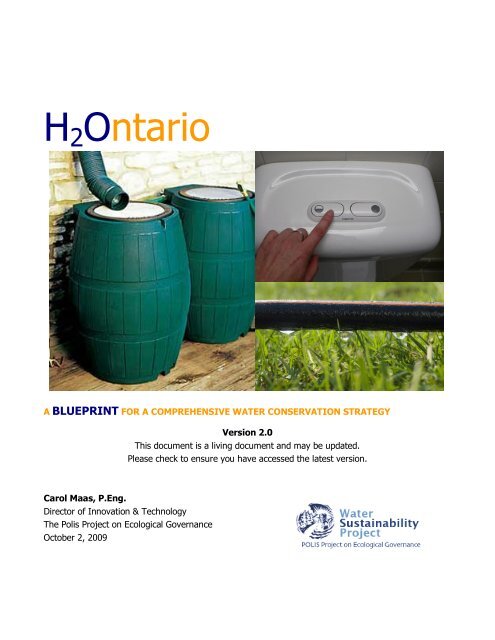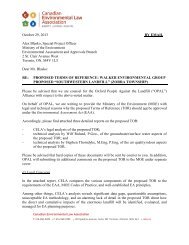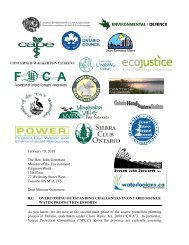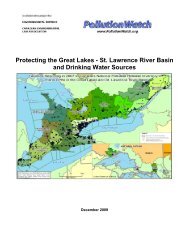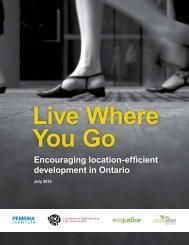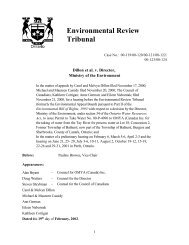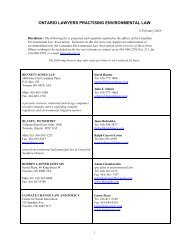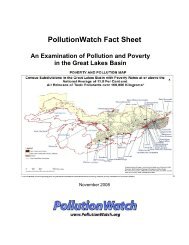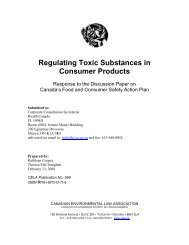H2Ontario - Version 2.0 - POLIS Water Sustainability Project
H2Ontario - Version 2.0 - POLIS Water Sustainability Project
H2Ontario - Version 2.0 - POLIS Water Sustainability Project
- No tags were found...
Create successful ePaper yourself
Turn your PDF publications into a flip-book with our unique Google optimized e-Paper software.
H 2 OntarioA BLUEPRINT FOR A COMPREHENSIVE WATER CONSERVATION STRATEGY<strong>Version</strong> <strong>2.0</strong>This document is a living document and may be updated.Please check to ensure you have accessed the latest version.Carol Maas, P.Eng.Director of Innovation & TechnologyThe Polis <strong>Project</strong> on Ecological GovernanceOctober 2, 2009
ACKNOWLEDGEMENTSDeveloping this Blueprint was a collaborative, iterative process, involving many experts in the field.Korice Moir and Matt Binstock contributed numerous hours to researching examples of best practicesand offering input into the suite of action items. Theresa McClenaghan and Sarah Miller at theCanadian Environmental Law Association (CELA) offered input and review from the earliest stages ofthis work. Glen Pleasance, Region of Durham, Bill Gauley, Veritec Consulting and Johann Manente,Region of Peel offered invaluable insight based on their expertise in municipal water conservation.Thank you to Rob de Loë at the University of <strong>Water</strong>loo for providing feedback based on extensiveresearch and field level practice and for responding to a seemingly unending stream of questions.Thank you to Tina Schankula at the Ontario Federation of Agriculture for providing insight into theagricultural sector. Thank you to all partners, who endorsed this work and provided review, includingthe CWWA National <strong>Water</strong> Efficiency Committee, Great Lakes United, Ecojustice (formerly Sierra LegalDefence Fund), Environmental Defence, CELA, The Alliance for <strong>Water</strong> Efficiency, FLOW, and TheCanadian Federation of University Women: Ontario Council.A special thank you is extended to Tim Morris, Programme Officer at the Gordon Foundation, forrecognizing the importance of this work, for connecting the many experts engaged, and for being aninvaluable source of knowledge. Finally, sincere thanks to Oliver Brandes and Susanne Porter-Bopp atthe <strong>POLIS</strong> <strong>Project</strong> for reviewing this work many, many times and for contributing their expertise andability to see the big picture.The development of the Blueprint was madepossible by the generous financial support of theWalter and Duncan Gordon Foundation.www.gordonfn.org<strong>H2Ontario</strong>: A Blueprint for a Comprehensive - 2 -<strong>Water</strong> Conservation & Efficiency Strategy
SIGNATORIESCANADIAN ENVIRONMENTALLAW ASSOCIATION<strong>H2Ontario</strong>: A Blueprint for a Comprehensive - 3 -<strong>Water</strong> Conservation & Efficiency Strategy
WHY A BLUEPRINT, WHY NOW?Jurisdictions around the world are increasingly recognizing that sound water management is thefoundation for economic and community prosperity. Ontario is beginning to take notice and iscommitting to new approaches to water management, from source protection to modernizing municipalinfrastructure to improved protection of lakes, streams and rivers.The Great Lakes-St. Lawrence River Basin Sustainable <strong>Water</strong> Resources Agreement, signed by Ontariowith nine other Great Lakes jurisdictions, requires each state and province in the basin to establishwater conservation goals, objectives and programs. Implementation of the recommended actions in ABlueprint for a Comprehensive <strong>Water</strong> Conservation and Efficiency Strategy would position Ontario as aregional leader on conservation.This Blueprint is being released in anticipation of the Province's <strong>Water</strong> Conservation and EfficiencyStrategy. The signatory groups are supportive of the input contained in this Blueprint and willparticipate in the Province's dialogue regarding water conservation and efficiency as it evolves.Part I provides background and context to the Blueprint, and outlines why a commitment to acomprehensive water conservation and efficiency strategy is so urgently needed. It discusses thebenefits of conserving water – including economic, energy reduction, and environmental protectionbenefits – and outlines opportunities to build on the existing foundation of water conservation policiesand practices in the province. It concludes by offering a vision for a sustainable water future for theprovince.Part II begins with a summary table of a Blueprint for a Comprehensive <strong>Water</strong> Conservation andEfficiency Strategy to achieve that vision, including priority areas, actions, and key actors needed tomake them happen. A detailed discussion of each of the elements of the Blueprint follows.<strong>H2Ontario</strong>: A Blueprint for a Comprehensive - 4 -<strong>Water</strong> Conservation & Efficiency Strategy
TABLE OF CONTENTSACKNOWLEDGEMENTS ............................................................................................................. 2SIGNATORIES ......................................................................... ERROR! BOOKMARK NOT DEFINED.WHY A BLUEPRINT, WHY NOW?.............................................................................................. 4TABLE OF CONTENTS ................................................................................................................ 5PART I - BACKGROUND AND CONTEXT ................................................................................... 6Why Conserve <strong>Water</strong>? ................................................................................................................6Benefits of Conserving <strong>Water</strong> ......................................................................................................7The Opportunity.........................................................................................................................9A Proposed Vision for A New <strong>Water</strong> Future.................................................................................11PART II - THE BLUEPRINT...................................................................................................... 12Blueprint Summary Table..........................................................................................................13Provide Leadership Direction & Accountability.............................................................................15Priority 1: Oversight.................................................................................................................................. 15Priority 2: Targets and Plans..................................................................................................................... 16Priority 3: Measuring Progress.................................................................................................................. 20Establish a Strong Foundation of Science & Data ........................................................................21Priority 4: <strong>Water</strong> Budgets & Baseline Data................................................................................................ 21Priority 5: Benchmarks .............................................................................................................................. 22Priority 6: Best Management Practices ...................................................................................................... 23Create a Culture of Conservation ...............................................................................................24Priority 7: Financial Incentives.................................................................................................................. 24Priority 8: Social & Technical Capacity..................................................................................................... 26Priority 9: Market Transformation............................................................................................................. 27Priority 10: Education ............................................................................................................................... 31H 2 O ONTARIO – BECOMING A LEADER IN WATER CONSERVATION .................................... 32ENDNOTES .............................................................................................................................. 33<strong>H2Ontario</strong>: A Blueprint for a Comprehensive - 5 -<strong>Water</strong> Conservation & Efficiency Strategy
PART I - BACKGROUND AND CONTEXTWhy Conserve <strong>Water</strong>?While we are surrounded by four of the largest lakes on the planet, a closer examination demonstratesthat Ontario’s water resources are not as abundant as we perceive. The Great Lakes are essentially arelic: a one-time gift of the glacial melt that occurred at the end of the last ice age. They replenish atan average rate of only one percent per year and are a fragile ecosystem in delicate balance. 1Relatively minor changes to their natural cycles and fluctuations can cause major disruptions toecosystem function that will impact the human populations that depend on them for drinking water,industrial production, and recreation. Biodiversity in the Great Lakes is already at risk. Humanintervention now can avoid future detrimental impacts on aquatic and other wildlife species dependenton the waters of the Great Lakes.Compared to other jurisdictions with similar living standards, Ontarians waste large amounts of water.On average, the per capita residential use of water in Ontario is 260 litres per day, close to twice theamount used in many European countries including the United Kingdom and Germany. 2 In the summer,municipal water use doubles in many communities as treated water is used for lawn watering, washingcars, or filling swimming pools.The Environmental Commissioner of Ontario has noted a “heightened concern” about waterwithdrawals in Ontario and a number of Ontario’s watersheds are showing signs of serious ecologicalstress. In 2007, seven conservation authorities had watersheds in Level II low water condition and inrecent years Spencer Creek in southwestern Ontario has “disappeared temporarily because of excessivewater takings.” 3Several communities in Ontario, such as the Regional Municipality of <strong>Water</strong>loo and the City of Guelph,are located away from the lakes and depend heavily on groundwater. Groundwater supplies typicallyhave a limited, and often unknown, sustainable groundwater yield, and yet a number of thesecommunities have also been identified by the Province as new growth regions. 4 The pressure forgrowth is resulting in what the Environmental Commissioner of Ontario calls “irreconcilable priorities”,which pit accommodating population increases against respecting the carrying capacity of thewatersheds in which these communities are located. 5Climate change is another significant challenge. While Ontario’s Greater Golden Horseshoe is projectedto grow by an additional 4 million people by 2031 – equivalent to creating a mid-sized city roughly thesize of Kitchener every year for the next 23 years 6 – climate change is predicted to diminish watersupplies in southern Ontario as a result of higher evaporation rates and less snow and ice cover in thewinter. 7Simply put, not only is there not as much water in Ontario as we think but rising demands for waterare on a collision course with declining water source availability.<strong>H2Ontario</strong>: A Blueprint for a Comprehensive - 6 -<strong>Water</strong> Conservation & Efficiency Strategy
Benefits of Conserving <strong>Water</strong><strong>Water</strong> conservation and efficiency are “no-regrets” strategies that can stimulate the economy, reduceenergy needs, and help protect the environment. For the purpose of this report, water efficiency isdefined as providing the same service more efficiently – using less water – for example by installingefficient toilets, faucets, and showerheads. <strong>Water</strong> conservation is defined as modifying the actualservice to use less water, such as planting native, drought tolerant plants instead of water intensiveturf, taking shorter showers, and reusing water in industrial processes.Stimulating the EconomyInvesting in water conservation and efficiency creates green jobs, prevents unnecessary governmentspending, and spurs innovation.∞ Green Jobs - Based on an economic study conducted by the Alliance for <strong>Water</strong> Efficiency (AWE),investments in water efficiency as a form of economic stimulus can be quickly deployed to yield15,000 to 22,000 new jobs for each $1.2 billion invested. 8 Importantly, these are jobs that cannotbe outsourced outside of Ontario, in service sectors such as plumbing, landscaping, engineering,construction and design, and in manufacturing sectors involved in supplying everything from rainbarrels to dishwashers.∞ Cost Savings - Ontario is struggling to keep up with the maintenance of existing waterinfrastructure. An estimated $25 billion is needed over the next 15 years to repair and update theprovince’s aging water infrastructure. 9 Public funds are therefore needed to focus on maintenanceas opposed to building new expensive and energy-intensive pipes and pumps for growingpopulations. Fortunately, water efficiency frees up new water, stretching the capacity of existinginfrastructure, deferring the costs of future infrastructure expansion, and resulting in considerablelong-term savings for citizens. For example, the Region of Peel has developed a water efficiencyplan to defer $112 million in new water supply infrastructure through a 12-year water efficiencyplan costing $33 million. 10 <strong>Water</strong> efficiency is an economical source of new water.∞ Health Protection – Contamination from lead pipes, in combination with other sources, can resultin levels of lead in drinking water known to cause developmental deficits in children. Investment ininfrastructure can offer health benefits in addition to reducing water loss. For example, the city ofToronto is replacing the old lead pipes in their distribution system which will simultaneously reduceleaks.∞ Innovative, Blue Technology – A report from New York based Lux Research, <strong>Water</strong> Cultivation:The Path to Profit in Meeting <strong>Water</strong> Needs, states that revenues of the world’s water-relatedbusinesses will rise from $522 billion in 2007 to nearly $1 trillion by 2020 and predicts that watershortages will drive the need for innovations that emphasize efficiency, reuse and sourcediversification. 11 With the right encouragement, Ontario’s water technology sector is poised to seizethis opportunity. A number of leading edge water and wastewater technology companies, 12nationally renowned research organizations, 13 and several water modeling software companies 14already call Ontario home. This existing network of expertise in innovative water solutions,particularly in water recycling and reuse technologies, presents a pivotal opportunity to expandOntario’s technology sector.<strong>H2Ontario</strong>: A Blueprint for a Comprehensive - 7 -<strong>Water</strong> Conservation & Efficiency Strategy
Reducing Energy ConsumptionEvery time we flush the toilet or turn on the tap, energy is washed down the drain. The cost ofpumping, distribution, and treatment of water and wastewater is a significant expense for most Ontariomunicipalities. 15 Saving water saves energy by reducing pumping, treatment, and heatingrequirements, reducing carbon dioxide emissions and ultimately saving money.∞ CO2 Savings - Toronto <strong>Water</strong>, the municipal operation responsible for water distribution inToronto, uses more electricity than the Toronto Transit Commission and five times the energyconsumed by all of the city’s streetlights and traffic signals. 16 As part of Toronto’s 2007 ClimateChange, Clean Air and Sustainable Energy Action Plan, the city explicitly acknowledges the need toincrease water efficiency as a means of reducing the approximately 550 million kWh used everyyear to treat water and help attain its stated reduction in greenhouse gases by 2011. 17∞ Cost Savings - Energy costs for water pumping and treatment cost the Region of Peel anestimated $25 million dollars in 2006. A study of Ontario municipalities by the Power ApplicationGroup Inc. noted that there has to date been a narrow focus on rapid payback energy efficiencyprograms such as compact fluorescent light-bulb (CFL) replacements. 18 The next generation ofenergy efficiency improvements will need to look beyond light-bulbs. <strong>Water</strong> efficiency andconservation is likely to become among the most cost effective energy reduction strategies formunicipalities. In California, for example, the Energy Commission found that implementation of allidentified water conservation measures could “achieve 95 percent of the savings expected from the2006-2008 energy efficiency programs, at 58 percent of the cost”. 19Protecting the Environment∞ Adaptation - Climate change will impact the hydrologic cycle, making our ecosystems,communities, businesses, and farmers vulnerable. Implementing water efficiency measures nowcan help make ecosystems and communities more resilient to long-term risks and reduce thevulnerability of all sectors to the impacts of a changing climate. 20∞ Mitigation - As described above, water efficiency and conservation presents a significantopportunity for reducing energy use, helping municipalities and the Province mitigate greenhousegas emissions and contribute to the global effort to slow the progression of climate change.∞ Ecosystem Health - Keeping sufficient water in watersheds, wetlands, and aquifers is critical toensuring ecosystem function and health. Functioning watersheds provide valuable ecosystemservices such as purification, flood protection, and habitat. Every litre of water saved representsadditional water available to maintain these critical ecosystems and the services they provide.<strong>H2Ontario</strong>: A Blueprint for a Comprehensive - 8 -<strong>Water</strong> Conservation & Efficiency Strategy
The OpportunityThe Ontario government’s mandate to develop a water conservation and efficiency strategy representsan enormous opportunity to propel Ontario into the 21 st century of water management.The Political Commitment - the mandatefor the strategy arises from a commitment madeby the Premier of Ontario, the Honourable DaltonMcGuinty, under the Great Lakes-St. LawrenceRiver Basin Sustainable <strong>Water</strong> ResourcesAgreement, a regional agreement that wassigned with Quebec and the eight Great Lakesstates. This agreement requires each state andprovince in the basin to establish waterconservation goals, objectives, and programs andhas established a number of regional objectivesfor conservation (see Box I).An Existing Framework - In fulfilling thispolitical commitment, Ontario has a number ofexisting instruments and policies to build on:Box I: Regional <strong>Water</strong> Conservation andEfficiency Objectives• Guide programs toward long-term sustainable water use• Improve monitoring and standardize data reportingamong state and provincial water conservation andefficiency programs• Adopt and implement supply and demand managementto promote efficient use and conservation of waterresources• Develop science, technology and research• Develop education programs and information sharing forall water users∞ The Green Energy Act – makes the link between energy and water and enables minimum standardsto be set for water efficient appliances such as toilets and clothes washers.∞ Permit to Take <strong>Water</strong> Program – under this program, the province is now collecting water useinformation from applicants, and use of conservation best practices are now a consideration fornew permits.∞ Clean <strong>Water</strong> Act – in the near future, water budgets will identify water-stressed watersheds as partof the provincial source protection framework.∞ Financial Plans Regulation – encourages full cost recovery and pricing of water and wastewater inOntario municipalities.∞ The Building Code Act – through regulation, this Act establishes Ontario’s Building Code (lastupdated 2006), which requires water efficient plumbing fixtures in buildings constructed afterJanuary 1, 1996.∞ Safeguarding and Sustaining Ontario’s <strong>Water</strong> Act – amends the Ontario <strong>Water</strong> Resources Act toenable volume-based fees for highly consumptive commercial and industrial water users.∞ Ontario Low <strong>Water</strong> Response – all permit holders in a watershed could be required to documenttheir water efficiency and conservation practices should a low water level be declared. 21∞ Environmental Farm Plans – offer an existing mechanism to encourage the adoption of waterconservation and efficiency best practices for agriculture.<strong>H2Ontario</strong>: A Blueprint for a Comprehensive - 9 -<strong>Water</strong> Conservation & Efficiency Strategy
Leaders in the FieldIn addition to building on existing instruments and policies, the province can also capitalize on theleadership already being shown by different actors and sectors. For example:∞ Municipal members of the Great Lakes and St. Lawrence Cities Initiatives have resolved to reducetheir water use by 15% by 2015.∞ Members of the CWWA and OWWA water efficiency committees are actively involved in waterconservation and many have plans to reduce water use by at least 10% within a 10 year period. 22∞ The City of Guelph is undertaking the first grey-water reuse pilot program in Ontario. Through the2009 pilot program 30 residential grey-water reuse systems will be installed in both new andexisting homes. The City's 2009 <strong>Water</strong> Conservation and Efficiency Strategy aims to install 200grey-water reuse systems and 200 rainwater harvesting cisterns in residential homes by 2019. 23∞ Conservation Authorities often have water stewardship and monitoring programs in place, and arenow engaged in drinking water source protection including the development of water budgets.∞ Agricultural sector representatives, including OMAFRA 1 and OFA 2 , are supportive of water efficientbest management practices such as water efficient irrigation and livestock watering practices. 24∞ Ontario is home to several municipal water efficiency networking organizations including theCanadian <strong>Water</strong> and Wastewater Association, the Ontario <strong>Water</strong> Works Association, and theCanadian constituent of the bi-national organization, the Alliance for <strong>Water</strong> Efficiency.∞ A growing number of water efficiency consultants and technology firms are also setting up shop inOntario. Examples include businesses that advise on municipal water conservation programming,internationally recognized experts on water efficiency standards for fixtures, and technology firmsoffering innovative rainwater harvesting, grey-water recycling, and wastewater reuse technologies.1 Ontario Ministry of Agriculture, Food and Rural Affairs2 Ontario Federation of Agriculture<strong>H2Ontario</strong>: A Blueprint for a Comprehensive - 10 -<strong>Water</strong> Conservation & Efficiency Strategy
A Proposed Vision for A New <strong>Water</strong> FutureGuiding this Blueprint for a Comprehensive <strong>Water</strong> Conservation and Efficiency Strategy is the vision ofa sustainable water future in Ontario. Our proposed vision is a commitment to:“No New <strong>Water</strong> Supplies”What does that mean? It means we stop the search for new supplies until maximum practicalconservation and efficiency is achieved. We commit to finding the water we need through the abundantsupply of “new water” that is being flushed down the drain. If we can find the funds to expand supply,Box II: Soft Path Core PrinciplesFour principles distinguish the soft path from conventionalplanning and management:• Treat water as a service rather than an end in itself.• Make ecological sustainability a fundamental criterion.• Match the quality of water delivered to that needed by the enduse• Plan from the future back to the present.Brandes & Brooks (2007)we can certainly find the funds toconserve. No New <strong>Water</strong> requires ashift to a comprehensive andstrategic approach to waterconservation and efficiency – a ‘softpath’ for water (refer to Box II). Itenables us to live within theecological limits of locally availablesupplies and it precludes newpipelines or diversions to distantlakes where the ecologicalconsequences cannot possibly beanticipated.A commitment to “No New <strong>Water</strong>” enables our energy use for water supply and treatment processes toremain constant, or decrease, balancing the imminent burden of rising energy costs for Ontario citizensand municipalities. It contributes to the fight against climate change, instead of exacerbating it, and itfosters resilient, adaptable communities. It ensures our watersheds provide safe drinking water,support livelihoods, and it means Ontario’s watersheds of the future will be the ideal habitat for diverseecosystems and a natural playground for our children and grandchildren.Moving to a vision of “No New <strong>Water</strong>” will unleash the potential of Ontario’s technological and socialinnovators and it will lead us to sustainable water use, in which a culture of water conservation isembedded in all that we do. This is Ontario’s water future.<strong>H2Ontario</strong>: A Blueprint for a Comprehensive - 11 -<strong>Water</strong> Conservation & Efficiency Strategy
PART II - THE BLUEPRINTThe Blueprint Summary Table introduces ten priority areas that should be incorporated into an effectiveprovincial strategy. These priority areas are complemented by a number of specific actions to beinitiated over the next three years. Key actors responsible for initiating each action are alsosuggested. All actions do not necessarily apply to all sectors; details surrounding each priority area andactions follow this Summary Table.Transitioning to a goal of “No New <strong>Water</strong> Supplies” in Ontario will require action within three keyelements of a comprehensive strategy, which guides the organization of this blueprint.1. The Provincial government, working closely with Municipalities, provides the leadership, directionand accountability to re-orient Ontario toward the vision of No New <strong>Water</strong>;2. <strong>Water</strong> use decision-making is informed by a strong foundation of science and data; and3. The government cultivates a new water ethic and stimulates a market transformation, creating aculture of conservation in Ontario.<strong>H2Ontario</strong>: A Blueprint for a Comprehensive - 12 -<strong>Water</strong> Conservation & Efficiency Strategy
Blueprint Summary TablePriority Areas Action Who1. Oversight1. Appoint a Chief <strong>Water</strong> Conservation Officer(CWCO)MOE 3Provide Leadership, Direction andAccountabilityEstablish A StrongFoundation of Scienceand Data2. Targets and Plans3. MeasuringProgress4. <strong>Water</strong> Budgets &Data5. Benchmarks6. Best ManagementPractices2. Implement a Provincial Target of No New <strong>Water</strong>Supplies3. Identify Stressed <strong>Water</strong>sheds & InitiateDevelopment of <strong>Water</strong>shed-Based Targets4. Establish Sector (Municipal, Industry, etc.)Targets, Performance Measures, and PlansCWCO 4CWCOCWCO5. Implement ‘Target 150’ as a Goal for Individuals WCTs 56. Require Permit Holders to Prepare Plans MOE7. Annual Reporting CWCO8. Establish a Database of <strong>Water</strong> Use MOE/MNR 69. Initiate Studies on Ecological <strong>Water</strong> Needs MOE/MNR10. Identify Sectoral Benchmarks for <strong>Water</strong>Conservation & Efficiency11. Identify Sectoral Best Management Practices for<strong>Water</strong> Conservation & EfficiencyWCTsWCTs3 Ministry of the Environment4 Chief <strong>Water</strong> Conservation Officer5 <strong>Water</strong> Conservation Teams (WCTs) include the CWCO, sector representatives (specifically municipal water efficiencystakeholder groups), government including a water conservation representative from each ministry, independent waterefficiency experts, First Nations, CA’s and/or Source Protection Committee members, public watershed protection groups, andother stakeholders6 Ministry of Natural Resources<strong>H2Ontario</strong>: A Blueprint for a Comprehensive - 13 -<strong>Water</strong> Conservation & Efficiency Strategy
12. Modify and Expand Existing Rebate andIncentive ProgramsMOE/MNR/MEI 7 /MRI 8 /MMAH 97. Financial Incentives13. Require Conservation for Infrastructure Funding MOE/MEI14. Invest in a Green Infrastructure Fund MEI15. Support Environmental Farm PlansMOE/OMAFRACreate a Culture of Conservation8. Social & TechnicalCapacity9. MarketTransformation16. Foster <strong>Water</strong> Efficiency Expertise MOE17. Provide Access to Toolkits and TechnicalResources18. Support Innovative Research & Development19. Mandate Meters20. Move Toward Full-Cost and Volume-BasedPricingMOEMOE/MNR/MEI/MRI/MMAHMOE/MMAHMOE21. Increase <strong>Water</strong> Charges for <strong>Water</strong> Users MOE22. Establish <strong>Water</strong>Sense Labeling Program inOntarioMOE/Fed Gov’t23. Require Minimum <strong>Water</strong> Efficiency Standards MOE/MEI24. Launch a Social Marketing Campaign MOE10. Education25. Support a Comprehensive Children’s EducationProgramMOE/MOEd 107 Ministry of Energy and Infrastructure8 Ministry of Research and Innovation9 Ministry of Municipal Affairs and Housing10Ministry of Education<strong>H2Ontario</strong>: A Blueprint for a Comprehensive - 14 -<strong>Water</strong> Conservation & Efficiency Strategy
Provide Leadership, Direction and AccountabilityProvide Leadership Direction & AccountabilityLeadership, direction, and accountability are essential drivers for a successful strategy. Leading byexample, establishing clear priorities, and defining roles and responsibilities of key actors are importantwhen implementing a plan of action. The strategy itself must have criteria against which to measureprogress, our leaders must be accountable for achieving that progress, and progress towards thestated targets must be conveyed to the public if it is to be successful.Priority 1: OversightThe Conservation Bureau and the Chief Energy Efficiency Conservation Officer were established by theProvince to advance an energy conservation culture in Ontario. <strong>Water</strong> efficiency would benefit from anequivalent role to advance a culture of water conservation. The appointment of a Chief <strong>Water</strong>Conservation Officer would ensure appropriate oversight with respect to the implementation of thewater conservation and efficiency strategy and its progress against conservation targets.Action 1: Appoint a Chief <strong>Water</strong> Conservation OfficerAppoint a Chief <strong>Water</strong> Conservation Officer with similar roles & responsibilities to the Chief Energy EfficiencyConservation Officer, including:• Measuring, tracking and reporting on the performance of the strategy.• Advising on relevant government policy for conservation and efficiency.• Establishing and implementing provincial, sectoral, watershed, and citizen water conservation andefficiency targets and plans.• Designating Priority Sectors (described in Action 4) required to implement targets and plans, includingOntario’s largest water using sectors.<strong>H2Ontario</strong>: A Blueprint for a Comprehensive - 15 -<strong>Water</strong> Conservation & Efficiency Strategy
Provide Leadership, Direction and AccountabilityPriority 2: Targets and PlansProvincial TargetAn overarching water conservation target is necessary to send a clear signal to the province as a wholethat conservation and efficiency are essential to our continued economic and ecological health.Naturally, there are challenges associated with setting overarching targets, especially in the absence ofsolid baseline information on existing water use and the potential for water savings in each sector. Yetin spite of these challenges, a target provides incentive for change and a benchmark with which togauge progress. Adopting a vision of No New <strong>Water</strong> Supplies, until all practical water conservation andefficiency has been achieved, inspires a paradigm shift towards water conservation without using anabsolute or percentage reduction target that may be difficult to quantify.Action 2: Implement a Provincial Target of No New <strong>Water</strong> SuppliesEstablish a water conservation target of No New <strong>Water</strong> Supplies for the entire province to communicate to allOntarians that the government is willing to provide the “leadership” necessary to advance a culture of waterconservation.<strong>Water</strong>shed-Based TargetsFrom an ecological perspective, the most appropriate scale for water conservation and efficiencytargets is the watershed. Depending on the number, size, and type of withdrawals, as well asprevailing geophysical and climate conditions, certain watersheds will face more water stress thanothers. Tailoring conservation targets to the level of stress within Ontario’s watersheds is the mosteffective way to respond to the needs of the ecosystems that depend on healthy rivers, lakes, andaquifers.Ontario is well positioned to initiate development of watershed-based maximum water withdrawallimits. The creation of water budgets under the Clean <strong>Water</strong> Act provide the necessary basis for settingboth maximum water withdrawal limits and targets for water conservation and efficiency at awatershed level. Targets should be ecologically relevant, and watersheds under known water quantitystress should be required to reduce water use immediately from current levels to avoid unknown andpossibly cumulative consequences of long term failure to meet ecological needs.A comprehensive watershed assessment of ecological needs for water would also be necessary toaccurately assess a sustainable level of water withdrawals. A number of Conservation Authorities arealready well-placed to assist the Province with identifying instream flow needs, provided they are giventhe resources and support to undertake these studies. The Province must provide sufficient resourcesfor this effort, and make hydro-geologic studies and data available to stakeholders to avoidredundancy.<strong>H2Ontario</strong>: A Blueprint for a Comprehensive - 16 -<strong>Water</strong> Conservation & Efficiency Strategy
Provide Leadership, Direction and AccountabilityAction 3: Identify Stressed <strong>Water</strong>sheds & Initiate Development of <strong>Water</strong>shed-BasedTargetsDevelopment of watershed-based maximum water withdrawals and water conservation targets should berequired by the Chief <strong>Water</strong> Conservation Officer, including a process that involves:• Identifying “stressed” watersheds, where:oA “stressed” watershed is defined as meeting at least one of the following conditions:The watershed is designated as a high use watershed under the Permit to Take<strong>Water</strong> Program.Source protection committees have identified water withdrawals as a risk to adrinking water source.Where low water levels have occurred, for example as identified by the Low<strong>Water</strong> Response Plan.<strong>Water</strong> budgets have identified that in-stream flow needs are at risk.• Informing the development of targets by Source Protection Committees, stakeholder consultation andConservation Authorities.• Responsibility for watershed-based targets ultimately resting with the Chief <strong>Water</strong> Conservation Officer.Sector Targets, Performance Measures, and PlansSector level targets, including municipal targets, are appropriate for setting targets that aremeasurable, realistic and inspire water users towards progressive action. Performance measures, “acharacteristic or metric that can be used to assess the performance aspects of a program or project,” 25are essential to effectively measure and monitor progress against targets. For example, a performancemeasure could be a percentage of communities that are fully metered or a percentage of businessesthat adopt a specific best management practice.Priority Sectors should include Ontario’s largest water using sectors. In Alberta, for example, the sevenlargest water using sectors are: Chemical and petrochemical; Forestry; Irrigation; Mining;Municipalities; Oil and gas; and Power generation. In Ontario, water charges now apply to highlyconsumptive industrial or commercial sectors such as water bottling, beverage manufacturers, canningfacilities, concrete manufacturers, and chemical producers. 26 These sectors, along with large nonindustrialwater takers, such as municipalities, large irrigation operations, and power generationfacilities would be logical sectors to designate Priority Sectors.Each sector has specific water use needs (quantity and quality), different best management practices,processes, designs, and technologies, as well as varied levels of progress to date and capacities toachieve further water conservation and efficiency goals. Targets and performance measures need to betailored to each sector based on these specific needs. Plans guide sectors toward achieving targets andperformance measures for improved water conservation and efficiency and should reflect bestmanagement practices with the sector.<strong>H2Ontario</strong>: A Blueprint for a Comprehensive - 17 -<strong>Water</strong> Conservation & Efficiency Strategy
Provide Leadership, Direction and AccountabilityAction 4: Establish Sector Targets, Performance Measures and Plans<strong>Water</strong> Conservation Teams (WCTs) develop sector-based water conservation and efficiency targets,performance measures, and plans for Priority Sectors (including municipalities) under the guidance of the Chief<strong>Water</strong> Conservation Officer. Specifically, the WCTs would:• Develop targets, performance measures and plans.• Post targets, performance measures and plans on the Environmental Bill of Rights Registry for publiccomment.Citizen TargetThe purpose of an absolute per capita water use target is to encourage all citizens in Ontario to adopta conservation ethic, regardless of a perceived abundance of water or low population growth rates. Anabsolute per capita target is much clearer than a percentage based target for which a reference pointmust be specified, and thereby encourages action despite an ill defined baseline. Citizens in Ontario aregenerally unaware of how much water they use. Providing a benchmark for efficient water use in thehome that can be achieved today with off-the-shelf technologies is therefore a useful tool for educatingcitizens.Getting to an urban residential water use of 150 litres per capita per day (LCD) in a generation isattainable providing appropriate actions are taken now. Queensland Australia recently reduced wateruse from 300 LCD to less than 140 LCD with their very effective Target 140 campaign. 27 According topreliminary estimates by Veritec Consulting, 150 LCD indoor residential use could be achieved passivelyby 2040 simply by mandating off-the-shelf high efficiency fixtures and appliances in all new homestoday and for all point of sale transactions by 2015. By taking the actions outlined in this blueprint,including supporting municipalities in their conservation programming, this process could be expeditedin order to reach the goal within a generation.Action 5:Implement ‘Target 150’ as a Goal for IndividualsImplement ‘Target 150 within a generation’ as a centerpiece of the government’s water conservation andefficiency strategy. Government support is critical to achieving this target, including:• Implementation of standards and labelling, rebates, incentives, implementing social marketingcampaigns, and by advancing new technology.• Commitment to banning 13 L toilets, and to mandating high efficiency (4.8 L) toilets by 2015, inaccordance with the precedent set by California. 28<strong>H2Ontario</strong>: A Blueprint for a Comprehensive - 18 -<strong>Water</strong> Conservation & Efficiency Strategy
Provide Leadership, Direction and AccountabilityPermit-Holder Conservation PlansApplicants for new or expanded permits to take water are currently required to document existing andplanned water conservation and efficiency best management practices (‘BMPs’) under the Permit toTake <strong>Water</strong> system. Although this requirement provides a good basis for encouraging water efficiency,the applicant is simply required to consult their relevant sector association to identify best practices.<strong>Water</strong> conservation and efficiency plans, combined with increased clarity and criteria for best practices,would prevent future inefficiencies in all “new” water takings. Some flexibility is required to account forsite specific conditions, for example drip irrigation is an agricultural best management practice that isnot feasible for all crops.Action 6: Require Permit Holders to Prepare Plans<strong>Water</strong> conservation and efficiency plans should be required by permit holders through a process that includes:• Establishing a reasonable schedule for phasing in requirements for water conservation and efficiencyplans to be prepared.• Requiring plans when:oooA new permit, or an expansion to an existing permit, is requested.The permit holder is a member of a Priority Sector.The permit holder is in a watershed identified as “stressed”.• Establishing sector specific templates for conservation plans to ensure permit applicants documentexisting and planned use of approved best management practices. The templates should besufficiently simple to be completed by individuals without hiring a professional.• Devising a flexible criteria system to guide approvals of new permits or requests for increased takingsbased on:oooAdoption of documented best management practices where applicable.Adherence to defined criteria in cases where well-known BMPs apply such as evidence ofvolume-based conservation pricing, outdoor water audits completed, and updating existingbuildings to incorporate water efficient fixtures.Require requests for new water withdrawals to be offset by reducing water use in otherareas within the watershed.<strong>H2Ontario</strong>: A Blueprint for a Comprehensive - 19 -<strong>Water</strong> Conservation & Efficiency Strategy
Provide Leadership, Direction and AccountabilityPriority 3: Measuring ProgressMeasuring and tracking the progress of the strategy is essential for ensuring accountability andenabling the strategy to adapt to changing societal and ecological contexts and new opportunities.Requiring major water use sectors to report progress against their own water conservation andefficiency targets, performance measures, and plans would be an important component of thereporting process. To ensure transparency, reporting should be available for public review. Thepotential for inaccuracies associated with self-reporting water use reductions should be addressedthrough actions such as independent auditing.Action 7: Annual ReportingThe Chief <strong>Water</strong> Conservation Officer produces a publicly available, annual report that summarizes progressmade against targets and plans, including:• The results of annual <strong>Water</strong> Conservation Team reports on progress against targets and plans.• Addressing the nature of ongoing barriers to better water conservation and efficiency including a reviewof existing policies.• Adapting plans, actions and policies to changing social, ecological and technical needs and opportunities.• Validating the information provided by permit holders, for example by undertaking random independentwater audits, to verify the reported progress in each sector.<strong>H2Ontario</strong>: A Blueprint for a Comprehensive - 20 -<strong>Water</strong> Conservation & Efficiency Strategy
Establish a Strong Foundation of Science & DataEstablish a Strong Foundation of Science & DataA solid foundation of science and data is necessary to establish effective baselines, assess the potentialfor conservation and efficiency, and develop robust and realistic targets and plans. We need to knowhow much water is available, how much is being used, and what opportunities exist to reduce wateruse and loss. Until the data is available, water use decisions should take a precautionary approach toprotecting long term ecosystem and human needs for water.Priority 4: <strong>Water</strong> Budgets & Baseline DataBaseline DataA water budget is a model of inflow, outflow, withdrawals and storage in a specific watershed. Itreflects the relationship between inputs such as precipitation and groundwater inflow, and outputs suchas evapotranspiration and water withdrawals, and it enables identification of stressed watersheds orareas of stress within a watershed. Understanding the relationship between ground and surface waterin the Great Lakes basin is also important for ensuring the sustainability of water resources in Ontario.Delineating aquifers, determining current rates of recharge, and the land area and soil type necessaryto ensure sustainable replenishment of groundwater sources are part of the baseline data that shouldbe collected.<strong>Water</strong> conservation and efficiency is a means to lessen the impacts of water use on a watershed.However, in order to understand if water conservation measures are having an impact on water use, itis necessary to first have baseline information on water use.Action 8: Establish Database of <strong>Water</strong> UseBegin consolidating information on the actual water use of various sectors and water users to create an accurateportrait of water withdrawals within the province. To ensure the database is effective:• Require data collection protocols and formats, through the Permit to Take <strong>Water</strong> (PTTW) program andthe Clean <strong>Water</strong> Act (CWA), be conducive to establishing current water use benchmarks and tomeasuring progress against performance measures.• Ensure information is publicly available and presented in a way that is easily understood by the averagecitizen.<strong>H2Ontario</strong>: A Blueprint for a Comprehensive - 21 -<strong>Water</strong> Conservation & Efficiency Strategy
Establish a Strong Foundation of Science & DataEcological Needs for <strong>Water</strong>It is critical that water budgets account for ecological water needs, not just human needs such asdrinking water supplies. Adequate flows in rivers and lakes xi are essential for healthy functioningecosystems, and the ecological services that these ecosystems provide. Assessing ecosystem needs forwater is necessarily complex; a precautionary approach should be adopted in the absence of certainty.Action 9: Initiate Studies on Ecological <strong>Water</strong> NeedsSupport development of watershed-based targets by working with Conservation Authorities to undertakecomprehensive studies of the ecological needs for water in their watersheds, by:• First completing studies on the ecological needs for water in “stressed” watersheds and ground wateraquifers.• Phasing in studies on the remaining watersheds and ground water aquifers.Priority 5: BenchmarksBenchmarks, a “standard by which something can be measured or judged”, are useful for comparingcurrent water use to best practices within sectors. For example, benchmarks for residential indoorwater use in Ontario have been stated as approximately 250 LCD prior to the 1996 Building Codechange, 200 LCD for new homes meeting the current code, 150 LCD assuming all fixtures are “highefficiency”, and as little as 120 LCD if “best in class” water efficiency measures are implemented. 29Similar numerical benchmarks for industrial, commercial and institutional water use are currently lessdefined or non-existent, largely because water is used in each of these sectors for widely varyingpurposes.Specific benchmarks for water use within a number of Priority Sectors could likely be developed, suchas the benchmarks identified for several types of food processing by RMIT University in Australia in its<strong>Water</strong> Saver Toolkit. 30Action 10: Identify Sectoral Benchmarks for <strong>Water</strong> Conservation & Efficiency<strong>Water</strong> Conservation Teams will identify sector specific water use benchmarks for Priority Sectors, includingexamining international examples of sector-specific benchmarks where applicable.xiRivers and lakes should not be construed to include man-made ditches that have not previously existed as naturalwatercourses.<strong>H2Ontario</strong>: A Blueprint for a Comprehensive - 22 -<strong>Water</strong> Conservation & Efficiency Strategy
Establish a Strong Foundation of Science & DataPriority 6: Best Management PracticesEach sector is anticipated to have a suite of BMPs, some of which can be, or are already, formalizedsuch as irrigation BMPs published by the Ontario Ministry of Agriculture, Food, and Rural Affairs orBMPs for residential water efficiency produced by the Ontario <strong>Water</strong> Works Association.Action 11: Identify Sectoral Best Management Practices for <strong>Water</strong> Conservation &Efficiency<strong>Water</strong> Conservation Teams will identify BMPs for Priority Sectors and conduct a barriers analysis to identifybarriers to adoption of BMPs that may include resource constraints, knowledge barriers and reluctance tomove from traditional practices.<strong>H2Ontario</strong>: A Blueprint for a Comprehensive - 23 -<strong>Water</strong> Conservation & Efficiency Strategy
Create a Culture of ConservationCreate a Culture of ConservationA strong foundation of science and data will tell us where we are today. Establishing conservationtargets and plans will set the goals for where we want to be tomorrow. The following priorities andactions are designed to answer the question, how do we get from today to where we want to betomorrow? Actions outlined here emphasize the Province’s leadership role to catalyze action bycommunities, businesses, and individual citizens to embrace a culture of water conservation.Priority 7: Financial IncentivesIn order to create a culture of conservation, governments will likely have to provide incentives totransition towards sustainable water use for a period of time.Rebates and IncentivesA number of retrofit rebate and incentive programs already exist in Ontario. Expanding these existingrebate and incentive programs to include water efficiency is a practical and cost effective way toincrease purchases and retrofits of water efficient fixtures and equipment. The incremental costs ofexpanding existing programs to include water conservation and efficiency are small in comparison tothe co-benefits of reduced energy costs for municipalities, the boost to innovative water technologyindustries, and the preservation of ecosystems.Action 12: Modify and Expand Existing Rebate and Incentive ProgramsEnsure that funding and rebate programs administered by the Ministry of Energy and Infrastructure and theOntario Power Authority recognize the water-energy nexus and include water efficiency provisions, such as:• Making water conservation measures eligible for funding and rebates in the Municipal Eco-Challengefund; the Electricity Retrofit Incentive Program and the Industrial Energy Efficiency Program.• Updating the existing 6L toilet rebate to High Efficiency (4.8 L) <strong>Water</strong>Sense approved toilets within the“Ontario Home Energy Savings” program. Also consider including efficient humidifiers and hot waterrecirculation systems.• Matching rebates offered by the Canadian ecoEnergy Retrofit for Small and Medium Organizations forretrofits in businesses that save both water and energy. Include rebates for water efficient pre-rinsespray valves for restaurants and food retailers.<strong>H2Ontario</strong>: A Blueprint for a Comprehensive - 24 -<strong>Water</strong> Conservation & Efficiency Strategy
Create a Culture of ConservationCriteria for FundingIt is important that provincial funding for water-related infrastructure and projects be used wisely. Aneffective way to ensure that taxpayer dollars are used to support sustainable water infrastructure andinnovative practices is to make water efficiency and conservation a condition for provincial and federalsupport. This approach is already a part of BC’s infrastructure granting program and is formallyrecognized in their provincial water strategy. 31Action 13: Require Conservation for Infrastructure FundingIdentify water-related government funding and programs for Priority Sectors and require water conservation andefficiency as conditions for funding. For example:• Require evidence of water conservation practices for requests for water supply funding in the Canada-Ontario Infrastructure Program (COIP). For example, comparison of a community’s water use againstperformance measures, such as benchmarks for residential per capita consumption, or adoption of BMPssuch as conservation-based pricing could be required.• Support Priority Sectors in achieving new criteria for funding by providing funds to secure “new water”through conservation programming.• Ensure no Federal funding is given to Ontario projects that have not received approvals and permitsGreen InfrastructureInvestments in green infrastructure would generate new employment opportunities, stimulate theeconomy in the short-term, ensure long-term benefits for the environment, and promote a shift to amore innovative economy. Smart spending on sustainable forms of water infrastructure, such as waterconservation and efficiency, should be prioritized over pouring money into out-dated approaches thatrely on building expensive, and energy-intensive pipelines, pumps, and plants that create new debt forfuture generations, encourage urban sprawl, and increase Canada's carbon emissions. Furthermore,pilot programs of innovative green infrastructure are needed to determine the potential for broad usein water conservation and efficiency planning.Action 14: Invest in a Green Infrastructure FundSupport an Ontario Green Infrastructure Fund (GIF) by investing funds collected from <strong>Water</strong> Charges or Permitfees or utilizing existing dollars such as the Canada-Ontario Infrastructure Program (COIP) and IndustryCanada’s Ontario Potable <strong>Water</strong> Program. The GIF should:• Fast-track infrastructure funding for the development of sustainable water infrastructure.• Include funding for water infrastructure repairs and leak detection, comprehensive water conservationand efficiency programs, stormwater management best practices, and pilot programs that advanceinnovative water practices such as rainwater harvesting, use of non-potable water sources, or soft pathplanning processes. 32<strong>H2Ontario</strong>: A Blueprint for a Comprehensive - 25 -<strong>Water</strong> Conservation & Efficiency Strategy
Create a Culture of Conservation<strong>Water</strong> Efficient AgricultureEnvironmental Farm Plans (EFPs) are voluntary assessments prepared by farm families to identify areasfor environmental improvement. 33 EFPs are an established and effective instrument for supportingagricultural Best Management Practices – defined as “a practical, affordable approach to conserving afarm's soil and water resources without sacrificing productivity”. 34Action 15: Support Environmental Farm PlansInvest in the Environmental Cost-Sharing programs of the Environmental Farm Plan for implementation of BestManagement Practices for agricultural water efficiency by increasing the funding caps and percentage of costsharefrom 30% to more than 50% for water conserving practices.Priority 8: Social & Technical CapacitySocial CapacityCompetent water efficiency practitioners are essential for transforming the economy from a hardinfrastructure supply-side paradigm to an innovative economy demand-side paradigm. Knowledgeable,creative practitioners that work to optimize water use efficiency will benefit Ontario’s economy now andinto the future. The Province should provide communities access to water efficiency knowledge in theform of in-house government expertise, experts within non-profit organizations and networking groups,training opportunities, and in some cases financial resources to hire practitioners.Action 16: Foster <strong>Water</strong> Efficiency ExpertiseFoster water efficiency expertise in all sectors by:• Developing government expertise in water conservation, efficiency and ecological needs for water toprovide advice and support to permit applicants, Source Protection Committees, OMAFRA, IrrigationAdvisory Committees and <strong>Water</strong> Use Co-operatives.• Providing funding through cost-shared programs and partnerships for businesses, municipalities,farmers, and industry associations to hire water conservation experts to assist with programming,develop expertise and transfer knowledge to permit holders.• Providing training and financial support to a central organization to deliver water conservation andefficiency auditing, rebate programs, and community based social marketing services for residential andICI sectors as has been done by Green Communities Canada 35 for energy efficiency and Well Awareprograms and by the California Urban <strong>Water</strong> Conservation Council. 36• Providing financial support to effective, capacity building networks knowledgeable in water efficientpractices such as the CWWA and OWWA <strong>Water</strong> Efficiency Committees, the Alliance for <strong>Water</strong> Efficiency,and the Ontario Federation of Agriculture.<strong>H2Ontario</strong>: A Blueprint for a Comprehensive - 26 -<strong>Water</strong> Conservation & Efficiency Strategy
Create a Culture of ConservationTechnical CapacityA recent CWWA Benchmarking initiative found that many municipalities across Canada do not fullyunderstand how water is used within their communities. Without this understanding targets aremeaningless. Technical resources such as toolkits, guidelines, templates, best practices, and modelbylaws that are easily standardized will ease the transition to water efficient communities.Action 17: Provide Access to Toolkits and Technical ResourcesEnable access to water conservation and efficiency auditing toolkits, detailed guidelines, templates for planning,model bylaws, best management practices, and other resources for all Priority Sectors. Work with existingclearinghouse(s) (e.g., the Alliance for <strong>Water</strong> Efficiency and OMAFRA) to provide a central location, familiar toeach sector, for all resources and tools.Research & DevelopmentOntario’s technology, service and academic sectors require support and encouragement to develop 21 stcentury solutions to the mounting challenges of global water scarcity. Innovative water conservingtechnologies, practices, tools and techniques that enable sustainable water use will be in high demandinternationally. Investing in this research today will enable water businesses, professionals andacademics, living and working in Ontario, to meet the demand for innovative services tomorrow.Action 18: Support Innovative Research and DevelopmentRe-allocate a portion of existing water research funding from end-of pipe solutions to support innovativesolutions, including:• Pilot programs to test new technologies, planning processes, and other innovative solutions such as socialmarketing programs and novel conservation programming.• <strong>Water</strong> conservation and efficiency technologies, practices, and tools.• Alternative, non-potable sources of water such as rainwater, grey-water, reuse and recycling.Priority 9: Market TransformationConservation should be an easy, automatic part of our daily interaction with water. Efficient technologycan help us achieve that. A market transformation could encourage businesses to develop and deliverinnovative, cost effective, water saving solutions. An awareness of the water-footprint of productscould better enable citizens to do their part to use water wisely in their homes and workplace.This transformation will eventually allow provincial and local governments to phase out rebates andfinancial incentives for water efficiency, because the right signals for citizens, businesses and<strong>H2Ontario</strong>: A Blueprint for a Comprehensive - 27 -<strong>Water</strong> Conservation & Efficiency Strategy
Create a Culture of Conservationcommunities will be embedded in our economy. But until this transformation penetrates our valuesystems and infuses the market, our leaders must initiate and guide this transition.MetersMetering water use is one of the most important BMPs for encouraging water conservation, and isessential for the adoption of any volume-based pricing structure. 37 The City of Calgary has observedthrough local studies “that metered customers use 60 per cent less water on average than customerson a flat rate because they are more conscious of where and how water is used”. 38 Nationally, a similartrend has been noted. Without metering, it is impossible to understand how much water is being usedand where the opportunities for savings lie. xiiAction 19: Mandate MetersMeters should be required in all new construction of homes, businesses and industry, through:• Mandating universal metering for all urban communities.• Requiring sub-metering for multi-residential buildings.• Encouraging metering in small communities, with financial and technical support provided as needed.Full-Cost and Volume-Based PricingOntario’s Financial Plans Regulation encourages municipalities to introduce full-cost pricing. Financialplans are required by December 2010 at the latest, depending on the municipality, and will outline thefull-costs associated with providing water. There are a large number of municipalities (low-income,small, northern, and First Nations) who may be unable to fully recover the costs of municipal waterinfrastructure and operation for a number of reasons. Special consideration would need to be given tothese municipalities. The intent of pricing water according to its full cost is to move away from aculture of “cheap water” in areas where residents can currently “afford” to waste water.The full cost analysis should extend to protecting the source, replacing aging infrastructure at areasonable rate, water conservation planning and programming, education, research, and treatment ofwastewater as opposed to a narrow focus on water treatment infrastructure. Full-cost, volume-basedwater pricing remains a key recommendation from the Environmental Commissioner of Ontario. TheProvince should aim to continue to move towards this goal, whilst avoiding undue hardship on lowincomecommunities. In particular, equitable access should be addressed by providing the first block ofwater at low or no cost to all consumers to ensure basic human water needs are met.xiiThe PTTW allowance for reporting pump records for small self-supplied license holders, such as small agriculturaloperations, is a reasonable approach to avoid a cost burden on rural families.<strong>H2Ontario</strong>: A Blueprint for a Comprehensive - 28 -<strong>Water</strong> Conservation & Efficiency Strategy
Create a Culture of ConservationAction 20: Move Toward Full-Cost and Volume-Based PricingConduct a review of financial plans submitted in accordance with the Financial Plans Regulation to identify gapsin responsible, sustainable planning for water provision. If a review of the financial plans suggests that full costand volume based pricing are not planned in the majority of urban communities, develop a plan of action toensure implementation of full cost and volume based pricing in these communities.In August 2007, the province introduced a water charge for highly consumptive industrial andcommercial water users. Starting on January 1, 2009, all “phase one industrial or commercial waterusers” are required to pay $3.71 for every million litres of water that they take each year. The statedpurpose of this charge was to recover the costs of the province’s water management programs and toencourage conservation. However, the Environmental Commissioner of Ontario has stated that: “[T]hislow fee will help cover only a small portion of the costs of the province’s needed water managementprograms, and furthermore, will do nothing to encourage conservation or efficient use of Ontario’swaters.” 39 The Commissioner has strongly urged the Ontario government to take a more expansiveapproach in the future. These charges should apply only to non-essential industrial and commercialwater takings, not to the minimum water necessary for ecosystems, food, and human health.Action 21: Increase <strong>Water</strong> Charges for <strong>Water</strong> Users<strong>Water</strong> charges should be increased to reflect the full value of the water withdrawn, including ecological valuesand the quantity and quality of the water being returned to the ecosystem. Actions include:• Increasing water charges for highly consumptive users.• Broadening the category of users subject to the water charge to include mining, pulp and paper, andthermal power generation. 40Efficient Products and BuildingsMunicipalities are spending millions of dollars per year on rebate programs that would no longer benecessary if water wasting fixtures (13L toilets, top-loading clothes washers, inefficient pre-rinse sprayvalves) were no longer available for purchase. The US Energy Policy Act sets minimum water efficiencystandards for both new construction and all point of sale transactions. 41 The Green Energy Act, recentlypassed into law, has the potential to similarly mandate minimum water efficiency standards for point ofsale transactions – potentially banning the sale of 13 L toilets.The Building Code changes in 1996 were instrumental in improving Ontario’s water efficiency.Mandating best available efficient fixtures, and updating specifications regularly, makes purchasing themost efficient technology easy and automatic for consumers and incentivizes development of newtechnology. Installing best available technology in all new construction is much more cost effectivethan conducting retrofits later, and ensures all new demands for water are the most efficient possible.Another key action is to make water conservation a simple choice for Ontario consumers by adopting<strong>Water</strong>Sense, the water efficiency equivalent of the successful ENERGY STAR consumer labelingprogram.<strong>H2Ontario</strong>: A Blueprint for a Comprehensive - 29 -<strong>Water</strong> Conservation & Efficiency Strategy
Create a Culture of ConservationAction 22: Establish <strong>Water</strong>Sense Labelling Program in OntarioPartner with the US EPA’s <strong>Water</strong>Sense program, for example by:• Encouraging Ontario organizations to become <strong>Water</strong>Sense partners including municipalities, builders,retailers, and irrigation professionals.• Advocating federally for a national organization to administer a Canadian <strong>Water</strong>Sense program,equivalent to its US EPA counterpart, in the same way Canada administers the EnergyStar programthrough Natural Resources Canada’s Office of Energy Efficiency.Action 23: Require Minimum <strong>Water</strong> Efficiency StandardsRequire minimum water efficiency standards that meet or exceed existing international standards, including:• Mandating best available technology and practices for new homes in the Ontario Building Code(OBC), such as:ooooMandate <strong>Water</strong>Sense approved fixtures and water efficient landscapes.Mandate plumbing rough-in’s that enable future water collection and use of alternative sourcesfor toilet flushing and lawn watering (purple pipes) as will be mandated in British Columbia by2010.Investigate the feasibility of hot water recirculation in new home construction.Increase the OBC review cycle to every 3 years to ensure standards reflect the most up to datewater efficient standards.• Extending standards beyond new construction to manufacturers and point of sale transactions, suchas:oooBan 13 L toilets.Mandate standards for all other high efficiency fixtures, that meet or exceed US standards.Mandate High Efficiency residential toilets (4.8 L) by 2015 as in California.• Educating plumbing inspectors and provide improved technical resources for innovative technologiessuch as rainwater harvesting and grey-water reuse (i.e. provide a series of technical templates andbackground to base approval decisions on).<strong>H2Ontario</strong>: A Blueprint for a Comprehensive - 30 -<strong>Water</strong> Conservation & Efficiency Strategy
Create a Culture of ConservationPriority 10: EducationThe myth of abundance has shaped our excessively high water use in Ontario. To affect a change inbehaviour in all sectors of society and to generate lasting support for water efficiency initiatives a newwater ethic must be instilled.Social marketing is an approach to developing a communication strategy to achieve specific behavioralgoals for a social good. Doug McKenzie-Mohr, a strong advocate for social marketing, has noted that“crisis behavior is myopic. We need to look more broadly at where we should be going as a society.” 42A well planned and comprehensive social marketing campaign is required to instill a long term cultureof water conservation in all citizens and sectors that extends beyond reactionary behaviour.Action 24: Launch a Social Marketing CampaignAs part of ‘Target 150’, develop and launch a marketing campaign that directly appeals to the different valuesthat influence citizens’ water use and pilot the campaign before expanding to the rest of the province. Forexample:• Conduct a barriers analysis to identify values-based decisions around water use and the barriers touptake.• Identify the most effective scales for different messaging based on the barriers analysis and supportcommunities in developing tailored campaigns as required.• Require water utilities to report per capita consumption, average monthly per capita consumptionincluding an estimated breakdown of indoor and outdoor water use and ‘Target 150’ on water utility bills,such as in the Target 140 Campaign in Queensland Australia. 43In 20 short years, the children of today will be the leaders and citizens of tomorrow. Education is thekey to fostering long term water stewardship and creating a culture of conservation.Action 25: Support a Comprehensive Children’s Education ProgramIncorporate water conservation into the provincial primary and secondary curriculum, including:• Principles of sustainable water use, ecosystem needs for water, water conservation, and the importanceof managing human activities to maintain the long term health of water ecosystems.• Requiring all students to complete at least one stream-health assessment, for example as required withinBC’s Living <strong>Water</strong> Smart Strategy.<strong>H2Ontario</strong>: A Blueprint for a Comprehensive - 31 -<strong>Water</strong> Conservation & Efficiency Strategy
Create a Culture of ConservationH 2 O ONTARIO – BECOMING A LEADER IN WATERCONSERVATIONThis Blueprint outlines a comprehensive and integrated approach to guide the development of theprovincial government’s water conservation and efficiency strategy. It is built on the broad vision of ‘NoNew <strong>Water</strong> Supplies’, meaning that the search for new water supplies ends and the collective efforts tounleash the full potential of water conservation begins.The 10 priority areas and 25 actions form a pragmatic and innovative framework that would makeOntario a leader in the Great Lakes-St.Lawrence River Basin, and place it on the road to becoming aworld leader in water conservation and efficiency. This plan establishes meaningful targets to spurmeaningful change and is designed to foster the creativity inherent within our communities andbusinesses in order to meet these targets.Critically, the actions within this plan recognize the fragility of our ecosystems, the need to reduce ourenergy costs, and the substantial economic opportunity associated with innovations in watertechnology. We urge the Ministry of the Environment, and the province as a whole, to act on this planand to instill a culture of water conservation within Ontario.The Blueprint signatory groups collectively commit to engaging in an ongoing dialogue with othergroups, organizations, and government to promote action towards a comprehensive water conservationand efficiency strategy.<strong>H2Ontario</strong>: A Blueprint for a Comprehensive - 32 -<strong>Water</strong> Conservation & Efficiency Strategy
ENDNOTES1 Ontario Ministry of the Environment (2008) Developing Ontario’s <strong>Water</strong> Conservation and EfficiencyGoals, Objective and Program: Background Information for August 28, 2007 Workshop.2 Environment Canada (2007) 2007 Municipal <strong>Water</strong> Use Report: Municipal <strong>Water</strong> Use 2004 Statistics.Available at: http://www.ec.gc.ca/water/en/info/pubs/sss/e_mun2004.pdf.3 Environmental Commissioner of Ontario (2008) 2007/2008 Annual Report – Getting to K(NO)WOntario’s Undervalued <strong>Water</strong>. Accessed at:http://www.eco.on.ca/eng/uploads/eng_pdfs/2008/ar2007.pdf.4 Ministry of Public Infrastructure Renewal (2006) Places to Grow: Growth Plan for the Greater GoldenHorshoe. Accessed at: http://www.placestogrow.ca/images/pdfs/fplan-eng-web-all.pdf5 Environmental Commissioner of Ontario (2007) Annual Report 2006-2007: Reconciling Our Priorities.Accessed at: http://www.eco.on.ca/eng/index.php/pubs/eco-publications/2006-07-annual-report.php.6 Ministry of Public Infrastructure Renewal (2006)7 de Loë, R.C. and A. Berg. (2006) Mainstreaming Climate Change in Drinking <strong>Water</strong> Source Protectionin Ontario. Prepared for Pollution Probe and the Canadian <strong>Water</strong> Resources Association (OntarioBranch). Ottawa, ON: Pollution Probe.8 Alliance for <strong>Water</strong> Efficiency (2008) Transforming <strong>Water</strong>: <strong>Water</strong> Efficiency as Stimulus and LongTermInvestment: Position Paper. Accessed at:http://www.allianceforwaterefficiency.org/uploadedFiles/News/NewsArticles/NewsArticleResources/<strong>Water</strong>%20Efficiency%20as%20Stimulus%20and%20Long%20Term%20Investment%20REVISED%20FINAL%202008-12-18.pdf.9 <strong>Water</strong> Strategy Expert Panel (2005) <strong>Water</strong>tight: The Case for Change in Ontario’s water andwastewater sector. Accessed at: http://www.mei.gov.on.ca/english/pdf/infrastructure/watertightpanel_report_en.pdf.10 Veritec Consulting Inc. (2004) Region of Peel <strong>Water</strong> Efficiency Plan. Accessed at:http://www.peelregion.ca/watersmartpeel/pdfs/wep-web-content.pdf.11 Lux Research (2008) <strong>Water</strong> Cultivation: The Path to Profit in Meeting <strong>Water</strong> Needs.12 General Electric (formerly Zenon Environmental), Trojan Technologies, etc.13 Canadian <strong>Water</strong> Network, Wastewater Technology Centre, NSERC Chair in Drinking <strong>Water</strong>Treatment, etc.14 Hydromantis, Envirosim, etc.15 Maas, C. (2009) Greenhouse Gas and Energy Co-benefits of <strong>Water</strong> Conservation. Accessed at:www.poliswaterproject.org/nexus<strong>H2Ontario</strong>: A Blueprint for a Comprehensive - 33 -<strong>Water</strong> Conservation & Efficiency Strategy
16 IndEco Strategic Consulting Inc. (2006) Report on the Development of the Energy Plan for Toronto.Accessed at:http://indeco.com/www.nsf/788895c29ec2338d85256a3300690fcc/41d661daccd1af98852572410061cf55/$FILE/Report%20on%20the%20development%20of%20the%20Energy%20Plan%20for%20Toronto.pdf.17 City of Toronto (2007) Climate Change, Clean Air, and Sustainable Energy Action Plan: Moving fromFramework to Action (June 13, 2007) Accessed at: http://www.toronto.ca/changeisintheair/index.htm.18 PAGI (2008) Ontario Municipalities: An Electricity Profile. January 25, 2008. Accessed at:http://www.amo.on.ca/AM/Template.cfm?Section=Conservation_and_Demand_Management&Template=/CM/ContentDisplay.cfm&ContentID=150110.19 Klein, G. et al. (2005) California’s <strong>Water</strong> – Energy Relationship. Final Staff Report. California EnergyCommission. November, 2005. Available at: http://www.energy.ca.gov/2005publications/CEC-700-2005-011/CEC-700-2005-011-SF.PDF.20 IDRC (2008) What is <strong>Water</strong> Demand Management? Accessed at: http://www.idrc.ca/en/ev-120476-201-1-DO_TOPIC.html.21 Ontario Ministry of the Environment (2008)22 RMSi (2009) City of Guelph <strong>Water</strong> Conservation and Efficiency Strategy Update. February 18, 2009.Accessed at:http://guelph.ca/uploads/ET_Group/waterworks/WCE%20Study/WCES%20Final%20Draft%20Report.pdf.23 RMSi (2009)24 Ontario Soil and Crop Improvement Program (2008). Environmental Cost-Share Opportunities forOntario Farmers. Accessed at: http://www.ontariosoilcrop.org/User/Docs/Programs/BMP%20Jan06.pdf25 U.S. Department of Education (2009) Glossary Accessed at:http://www.ed.gov/fund/grant/about/grantmaking/glossary.html.26 Ontario Ministry of the Environment (2008)27 Queensland <strong>Water</strong> Commission (2009) About Target 140 Accessed at:http://www.target140.com.au/About+Target+14028 California Bill AB 715 (2007) http://info.sen.ca.gov/pub/07-08/bill/asm/ab_0701-0750/ab_715_cfa_20070908_153855_sen_floor.html29 Veritec Consulting (2008) <strong>Water</strong> Savings Potential in New Homes30 <strong>Water</strong> Saver Toolkit (2009) An online resource by Plenty Food Group. Accessed at:http://www.plentyfoodgroup.com.au/water/31 British Columbia’s Ministry of the Environment (2009) Living <strong>Water</strong> Smart British Columbia’s <strong>Water</strong>Plan, Actions at a Glance. Accessed at: http://www.livingwatersmart.ca/actions.html<strong>H2Ontario</strong>: A Blueprint for a Comprehensive - 34 -<strong>Water</strong> Conservation & Efficiency Strategy
32 Brandes, O. and D. Brooks (2007) The Soft Path for <strong>Water</strong> in a Nutshell. Accessed at:http://www.poliswaterproject.org/sites/default/files/nutshell_revised_aug07_lowres.pdf.33 OMAFRA (2009) Canada Ontario Environmental Farm Plans. Accessed at:http://www.omafra.gov.on.ca/english/environment/efp/efp.htm#intro34 OMAFRA (2009) Best Management Practices Series. Accessed at:http://www.omafra.gov.on.ca/english/environment/bmp/series.htm35 Green Communities Joint Programs (2009) Programs facilitated by Green Communities Canada.Accessed at: http://www.gca.ca/indexcms/index.php?programs#jp36 California Urban <strong>Water</strong> Conservation Council, Smart Rebates Program. Accessed at:http://www.cuwcc.org/smartrebates-utilities.aspx37 Brandes, O.M., Maas, T. and E. Reynolds (2006) Thinking Beyond Pipes and Pumps: Top 10 WaysCommunities Can Save <strong>Water</strong> and Money.http://www.polisproject.org/PDFs/ThinkingBeyond_eng_lowres.pdf38 CBC News (2009) City fast tracks mandatory meter conversion. Accessed at:http://www.cbc.ca/canada/calgary/story/2009/03/25/cgy-calgary-water-meters.html39 Environmental Commissioner of Ontario (2008)40 Environmental Commissioner of Ontario (2008)41 Alliance for <strong>Water</strong> Efficiency (2009) Device Distribution Program Introduction. Accessed at:http://www.allianceforwaterefficiency.org/Device_Distribution.aspx42 Quinn, L. (2009) Doug McKenzie-Mohr: Legendary Master of Social Marketing Goes Beyond theBrochure Interview. Accessed at: http://www.hopedance.org/cms/content/view/375/32/43 Lessons on water conservation from Down Under. January 9, 2009. Nudge. Accessed at:http://nudges.wordpress.com/2009/01/page/3/<strong>H2Ontario</strong>: A Blueprint for a Comprehensive - 35 -<strong>Water</strong> Conservation & Efficiency Strategy


